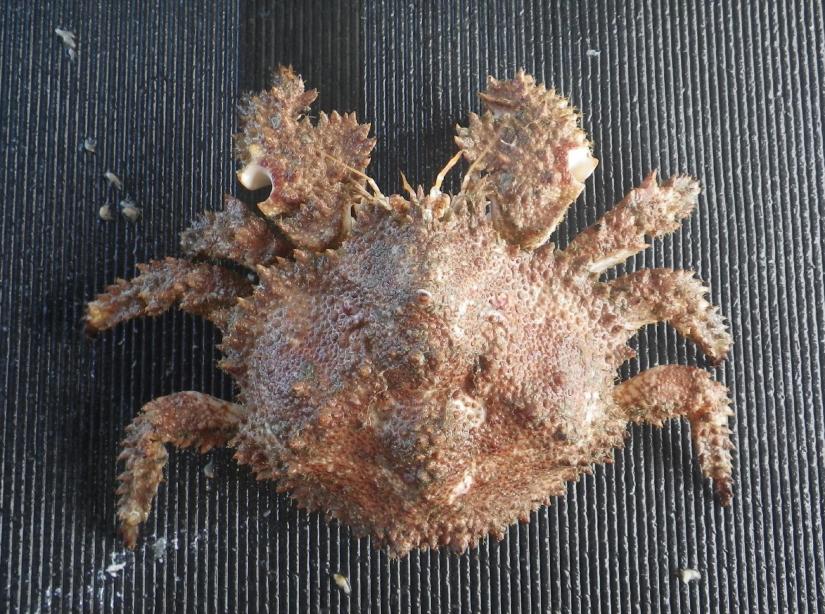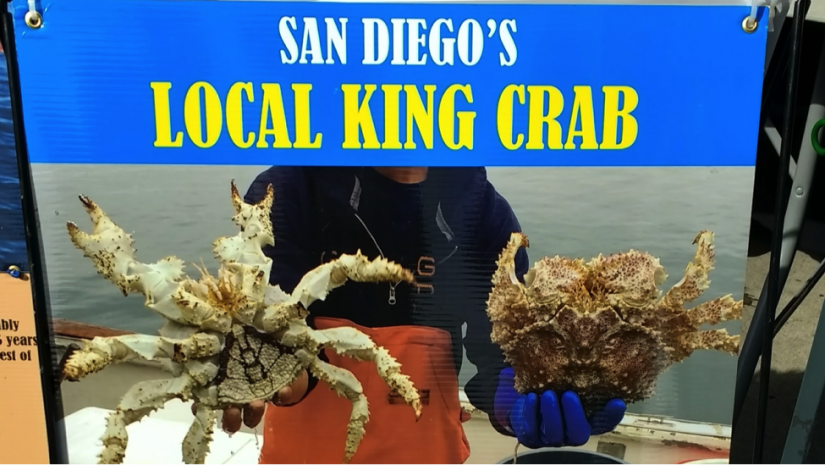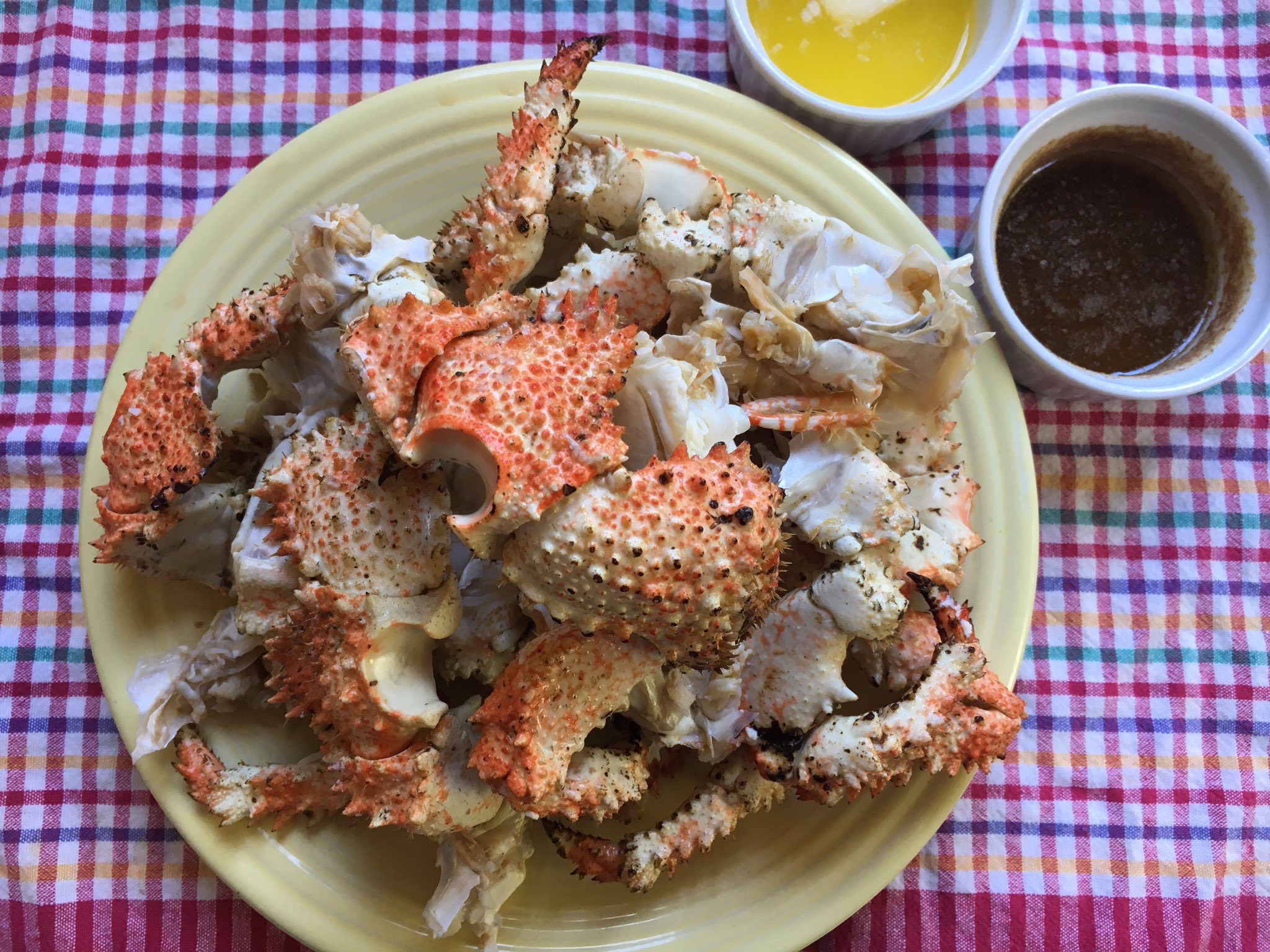Brown Box Crab
Lopholithodes foraminatus
The Science
THE SCIENCE
Brown box crab is a type of king crab, like the better known Alaskan king crab.

Taxonomic description
- Carapace grows up to 15 cm (6 in.) across, it is red-brown or tan in color with white and purple patches, and small spines. [2,3]
- When disturbed, it folds its legs and abdomen tightly together, so that it appears like a tight box or ball. [2]
- Has a calcified abdomen, with relatively short legs, and its fifth pair of legs are small and folded under the carapace, making it seem as if it only has four pairs of legs. [2,7]
- While buried, two circular holes (foramins) in the claws allow for water circulation to the gills. [2]
- Its large claw (usually the right) has blunt white teeth, while the small claw has sharp teeth. [2]
Distribution
- Range extends from Kodiak Island, Alaska, to San Diego, California. [3]
Life history
- Lives in aggregations, moves together, and molts at similar times within the aggregation. [7]
- In British Columbia, it has a biennial (two-year) breeding cycle; females molt and breed in mid-summer, brood eggs and larvae for 18 months, and release zoeae over ~69 days during the second winter/early spring (Feb-April) after breeding. The life cycle may be shorter and brooding may begin earlier (February) in Southern California. [2,7]
- Passes through four larval stages before becoming a juvenile and gaining the ability to walk. [2]
Habitat
- Resides in depths of low intertidal to ~600 m (1968 ft), but is usually found deeper than 18 m on muddy bottoms or on rocky faces over mud. [2,3]
- Scoops up mud to feed on bivalves and organic debris, and also feeds on brittle stars and sea urchins. [3]
- Is preyed upon by octopus, and may be parasitized by commensal organisms including snailfish, whose eggs and larvae can be found on crab gill filaments, and polychaete tubeworms, hydrozoans, and small bivalves on brooding and post-brooding females. [2,8]
The Fishery
THE FISHERY
Once only caught as incidental catch, there is now an experimental fishery targeting this crab!

Seasonal availability
- Year round.
Regulatory and managing authority
-
As established by the Marine Life Management Act, the California Fish and Game Commission (CFGC) regulates the fishery, and the California Department of Fish and Wildlife (CDFW) manages this fishery in state waters. [1,4]
-
Currently there is no established fishery management plan, but California Sea Grant, the Pacific States Marine Fisheries, the Ocean Protection Council, CDFW, and NOAA Fisheries are presently working with fishermen to collect information about this fishery. [4]
Gear type
- Trap caught. [7]
Status of the fishery
- Box crab is an emerging fishery in California. An experimental permit system is currently being explored. [1,4]
Potential ecosystem impacts
- Traps can be modified to target specific species, but there is some risk that vertical lines running from the traps may entangle sea turtles and marine mammals. [9]
The Seafood

References
[1] Box Crab Pilot Project: Electronic Monitoring for an Experimental Fishery. n.d. Web. https://opc.ca.gov/box-crab-pilot-project-electronic-monitoring-for-an-…. Accessed 21 August 2020.
[2] Cowles, D., 2008. Invertebrates of the Salish Sea: Lopholithodes foraminatus. Web. https://inverts.wallawalla.edu/Arthropoda/Crustacea/Malacostraca/Eumala…. Accessed 27 May 2017.
[3] NOAA Fisheries Alaska Fisheries Science Center. Web. https://www.afsc.noaa.gov/kodiak/photo/crabboxa.htm. Accessed 27 May 2017.
[4] Julia, Coates. 2018. Brown Box Crab Experimental Gear Permit Planning Update. California Department of Fish and Wildlife. Web. https://nrm.dfg.ca.gov/FileHandler.ashx?DocumentID=160457. Accessed 21 August 2020.
[5] California Department of Fish and Wildlife. Web. https://www.wildlife.ca.gov/Licensing/Commercial/Descriptions. Accessed 28 May 2017.
[6] Major, D. 2017. Interview with San Diego Commercial Fisherman, Dan Major. F/V Plan B. San Diego, California. 29 April 2017.
[7] Zhang, Z.Y., et al. 1999. A Review of the Biology and Fisheries of the Box Crab (Lopholithodes foraminatus Stimpson) in British Columbia. Fisheries and Oceans Canada. Available: http://www.dfo-mpo.gc.ca/Library/240697.pdf.
[8] Peden, Alex E., and Cathryn A. Corbett. 1972. Commensalism between a liparid fish, Careproctus sp., and the lithodid box crab, Lopholithodes foraminatus. Can. J. Zool. 51: 555-56.
[9] Fishing Gear: Traps and Pots. 2019. NOAA Fisheries. Web. https://www.fisheries.noaa.gov/national/bycatch/fishing-gear-traps-and-…. Accessed 21 August 2020.
[10] Dungeness Crab, Web. Nutritionvalue.org. Accessed 21 September 2017.
[11] Box Crabs-Picking and Cleaning 101. 2015. The Backyard Gourmand-San Diego. Web. http://backyardgourmandsandiego.blogspot.com/2015/02/box-crabs-cleaning…. Accessed 21 August 2020.
[12] Box Crabs-The First Taste. 2015. The Backyard Gourmand-San Diego. Web. http://backyardgourmandsandiego.blogspot.com/2015/01/box-crabs-first-ta…. Accessed 21 August 2020.
[13] Box Crabs-Cooking (Steaming) 101. 2015. The Backyard Gourmand-San Diego. Web. http://backyardgourmandsandiego.blogspot.com/2015/01/box-crabs-cooking-…. Accessed 21 August 2020.
[14] Ginger and Scallion Crab. n.d. Rasa Malaysia. Web. https://rasamalaysia.com/ginger-and-scallion-crab/. Accessed 21 August 2020.
[15] Wilkes, M. and Wilkes, K. Cooks with Soul. 2019. Air Fryer Crab Cakes. Web. https://cookswithsoul.com/air-fryer-crab-cakes/. Accessed 8 January 2021.
[16] Young, A. iNaturalist. 2018. Digital image. Web. https://www.inaturalist.org/photos/14572488. Accessed 12 February 2021.
[17] aaronbaldwin. iNaturalist. 2014. Digital image. Web. https://www.inaturalist.org/photos/11876843. Accessed 12 February 2021.
[18] McKinnon, L. Twitter. 2017. Digital image. Web. https://twitter.com/805foodie/status/932066107195777024?lang=en. Accessed 12 February 2021.
[19] OC Wild Seafood. Viet Chef. Live Brown Box Crab. Web. https://vietchef.com/orange-county/live-brown-box-crab-2294.html. Accessed 4 January 2022.



